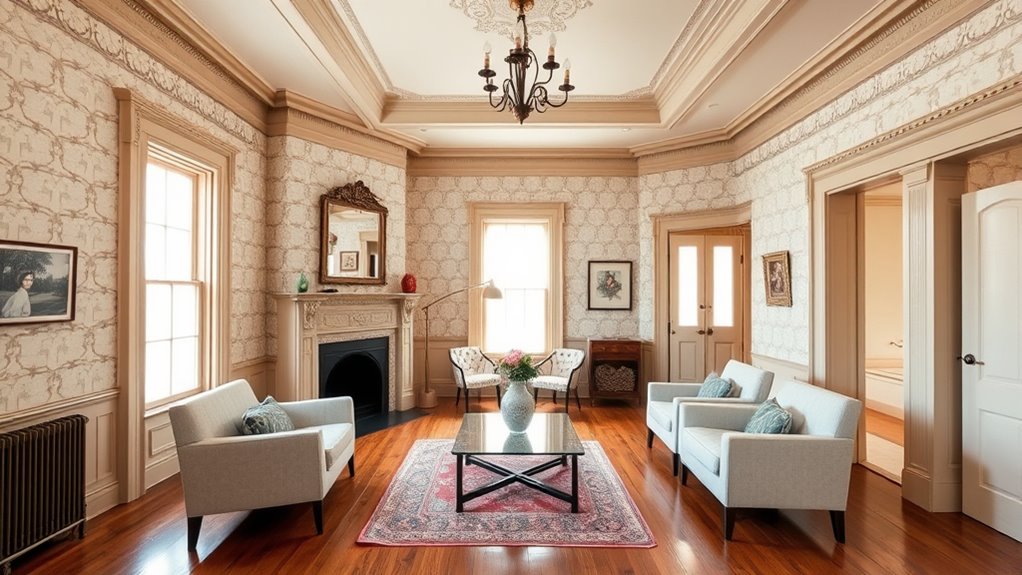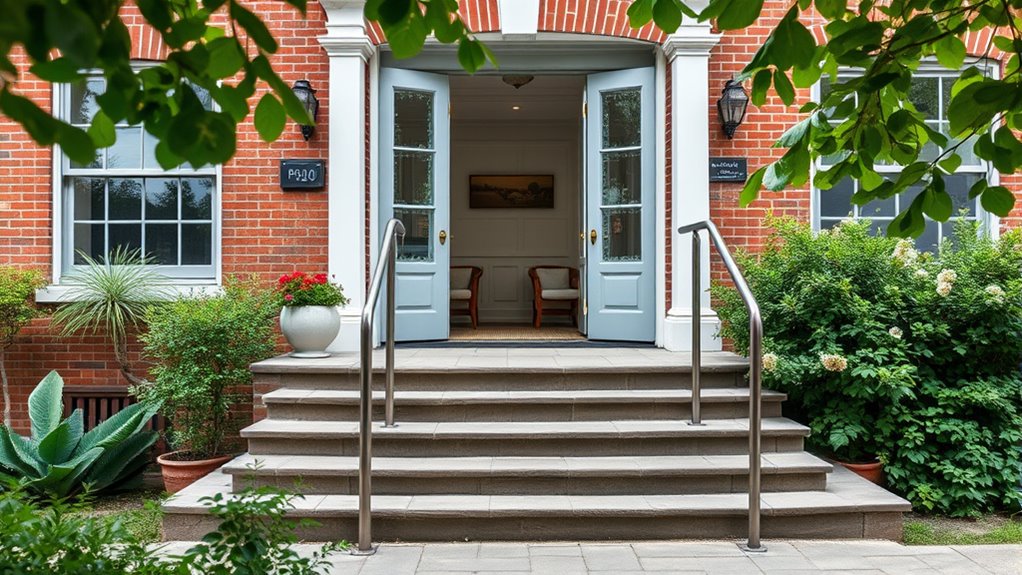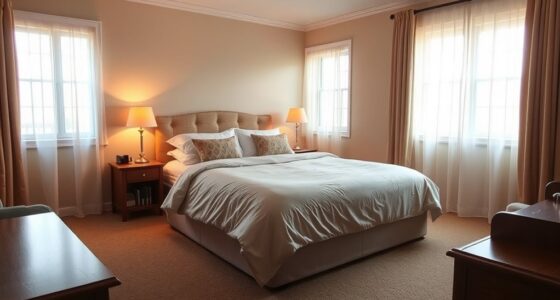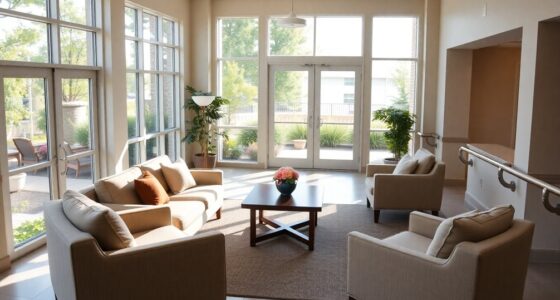Adapting a historic home for senior needs involves balancing preservation with modern accessibility. You can add features like non-invasive ramps, grab bars, and widened doorways while respecting the home’s original charm. Updating insulation, sealing drafts, and upgrading systems improve energy efficiency without damaging delicate features. Expert advice ensures upgrades meet preservation guidelines while enhancing safety. If you want to learn more about preserving the home’s character while ensuring comfort, keep exploring this essential process.
Key Takeaways
- Incorporate non-invasive, accessible modifications like grab bars and widened doorways that respect historic architecture.
- Use discreet, energy-efficient solutions such as interior storm windows and minimal structural changes for comfort and safety.
- Install modern, low-profile HVAC and lighting systems that enhance comfort without damaging original features.
- Collaborate with preservation specialists to ensure adaptations comply with historic preservation guidelines.
- Plan for long-term sustainability by integrating smart home technologies and durable, compatible materials.

Have you ever wondered how to preserve a historic home’s charm while making it functional for modern living? It’s a balancing act that involves careful planning and understanding of both preservation challenges and the importance of energy efficiency. You want to honor the original architecture and character of the home, but you also need to guarantee it meets today’s standards for comfort and sustainability. This means making smart upgrades that don’t compromise its historic integrity, which can often be tricky given the preservation challenges involved. Many older homes weren’t built with energy efficiency in mind, so you might find yourself facing issues like drafty windows, outdated insulation, and inefficient heating or cooling systems that drive up utility bills and reduce comfort.
Balancing historic charm with modern energy efficiency requires careful planning and expert solutions.
To address these issues, you need to carefully select modifications that respect the home’s original features. For instance, instead of replacing historic windows outright, you could install interior storm windows or add weatherstripping to seal drafts. These small changes improve energy efficiency without sacrificing the home’s vintage look. When it comes to insulation, you might consider using non-invasive methods like blown-in insulation in attics or wall cavities, ensuring you don’t damage delicate plaster or woodwork. The challenge is finding solutions that balance energy savings with preservation, which often requires expert advice and a nuanced approach. Additionally, understanding home efficiency standards can help guide your upgrades to meet current requirements while maintaining historical integrity. Incorporating energy-efficient upgrades thoughtfully can also help reduce long-term costs and environmental impact. Exploring sustainable building materials can further enhance the home’s energy performance and maintain its historic appeal.
You also face the challenge of upgrading the home’s systems to meet modern standards without erasing its historic authenticity. Installing a new HVAC system, for instance, might seem straightforward, but it could mean modifying walls or ceilings that are part of the home’s historic fabric. To mitigate this, you can opt for ductless mini-split systems that are less invasive and offer efficient climate control. Additionally, incorporating energy-efficient lighting and appliances helps reduce overall energy consumption, making the home more sustainable while maintaining its charm. Developing a comprehensive plan that considers both preservation and efficiency can lead to more creative solutions that enhance the home’s value and functionality. It’s also helpful to consider local preservation guidelines to ensure your upgrades are compliant and respectful of the home’s historic status.
Another aspect to consider is how these upgrades impact the home’s appearance and structure. You want your modifications to be discreet, preserving the aesthetic appeal for future generations. This often involves working with preservation specialists who understand the nuances of historic properties and can recommend solutions that blend seamlessly with the original design. By thoughtfully tackling preservation challenges and prioritizing energy efficiency, you can create a home that respects its past while comfortably serving your needs today. This way, you ensure that your historic residence remains a treasured piece of history, adaptable and sustainable for years to come.
Frequently Asked Questions
What Are the Legal Considerations When Modifying Historic Property?
When modifying historic property, you need to take into account zoning regulations that might restrict certain changes. You should also explore eligibility for historic tax credits, which can help offset restoration costs. Make sure to get the necessary permits and follow local preservation guidelines. Consulting with local authorities or preservation organizations ensures your modifications comply legally, helping you preserve the property’s historic integrity while making necessary updates.
How Can I Ensure Safety Without Compromising Historic Integrity?
Your home’s safety is essential—don’t let its historic charm be overshadowed by risks. You can achieve this by carefully blending safety upgrades with preservation efforts, like installing non-slip flooring, grab bars, and improved lighting that won’t compromise its character. Work with specialists who understand historic integrity, ensuring safety measures enhance rather than detract from your home’s unique charm. This way, you safeguard loved ones without sacrificing the home’s timeless beauty.
What Are Cost-Effective Options for Modern Upgrades?
You’re looking for cost-effective options for modern upgrades, and affordable solutions can make a big difference. Focus on sustainable upgrades like energy-efficient lighting, low-flow fixtures, and weatherproofing to reduce long-term costs. Installing grab bars and non-slip flooring enhances safety without sacrificing style. Prioritize upgrades that balance affordability with preserving your home’s character, ensuring you get practical improvements that last and support your needs today and tomorrow.
How Do I Get Approval From Preservation Authorities?
To get approval from preservation authorities, you should first research their specific guidelines on historic properties. Prepare detailed plans showing how your accessibility upgrades and modern design integration respect the home’s original features. Submit these proposals for review, highlighting the necessity of upgrades for senior accessibility. Engage with the authorities early, ask for feedback, and be open to making adjustments to guarantee your project aligns with preservation standards.
Are There Grants or Incentives for Renovating Historic Homes?
You can find grants and incentives like Historic Tax Credits and Preservation Grants that support renovating historic homes. These programs are designed to encourage preservation while modernizing spaces, especially for seniors. You should research local, state, or federal programs available in your area. Applying for these incentives often involves meeting specific criteria and working with preservation authorities, but they can markedly reduce your renovation costs and help you maintain the home’s historic integrity.
Conclusion
By embracing your historic home’s timeless charm, you’re not just preserving a building—you’re safeguarding a legacy. As you adapt its features to meet modern needs, you’re weaving tradition into everyday life, creating a sanctuary that stands resilient and welcoming. This transformation symbolizes respect for the past and hope for the future, ensuring your home remains a cherished haven for generations to come. In doing so, you honor history while shaping a brighter tomorrow.









